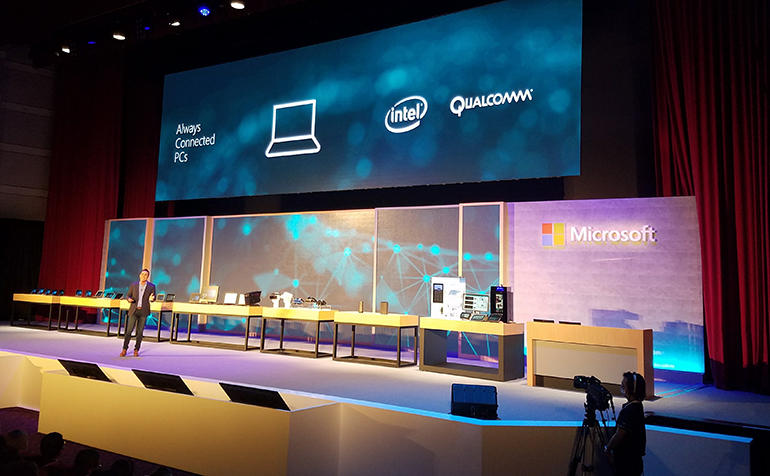
New ARM processors for mobile devices tailored to AI and VR
In separate events at Computex, Qualcomm and Microsoft made a compelling case for a new class of thin, fanless laptops with broadband wireless, significantly longer battery life, and the full Windows 10 experience. And, as expected, the companies announced that several major OEMs, including Asus, HP, and Lenovo, will be delivering the first Always Connected PCs. The concept sounds great, but none of these were on display in Taiwan, and for now, the companies are offering no details on the devices.
Cellular laptops with an x86 processor and a separate modem — generally from Qualcomm — have been around for a decade. The Always Connected PC is different because it is based on a 10nm Snapdragon 835 processor typically found in high-end smartphones such as the Samsung Galaxy S8. This offers several potential advantages.
Read also: Qualcomm inks deal to build mobile Windows 10 PCs with Asus, Lenovo, HP | First ‘Always Connected’ Windows 10 on ARM PCs are coming from ASUS, HP, Lenovo | ARM has designs on more than mobile | Intel rediscovers the desktop
First, the chip has an integrated X16 LTE modem with peak download speeds of 1Gbps. You are unlikely to see that in the real world, of course, but LTE-Advanced networks will almost certainly deliver speeds in excess of the 40Mbps average speed of wired broadband in the US. The chip also has 2×2 802.11ac MU-MIMO for Wi-Fi connectivity. Second, the Snapdragon 835 only draws around 3 to 5 watts, so battery life is expected to be at least 50-percent better than comparable x86 laptops, though Qualcomm hints that OEMs are seeing much bigger gains in their testing. That suggests true all-day battery life. Finally, the highly integrated mobile SoC reduces board area by nearly a third, which means the OEMs can get more creative with designs.
These devices will also fully support Connected Standby, which includes phone-like Instant On, a persistent background connection for syncing data, and the ability to summon Cortana with your voice when the system is in standby. Intel and Microsoft has been talking about these features for some time as well — Microsoft now seems to be referring to it as Modern Standby — but until recently the hardware and software implementation has fallen short. Qualcomm says that Snapdragon-based systems should last four- to five-times longer on standby.

The real breakthrough here is a version of Windows that runs not only Universal Windows Apps but also legacy Win32 applications. “Windows 10 is Windows 10,” said Don McGuire, a vice president of product marketing at Qualcomm, in an interview. “This is not Windows RT Version 2.0.” In a demonstration using one of its MTPs (Mobile Test Platforms), Qualcomm showed how these devices can run the full version of Office, creating PivotTables with a large spreadsheet, stream YouTube 1080p video, and download a 30-minute 1.9GB movie in about 40 seconds reaching speeds of around 370Mbps. Overall, Qualcomm said its Always Connected PCs should perform at roughly the same level as laptops with Core m3 or fan-less implementations of Core i5 (which are throttled to meet thermal limits).

Aside from the Windows port, Microsoft’s other major contribution to this project is the eSIM technology. Based on a GSMA standard called Remote SIM Provisioning, eSIM is a programmable SIM — no more swapping tiny SIM cards in and out of trays — that makes it easier to activate a new device by simply entering your mobile number. AT&T and T-Mobile were among several carriers worldwide that have agreed to support eSIM. “We need to make it easy and seamless for customers to get connected,” said Matt Barlow, Microsoft’s Corporate Vice President of Windows Marketing, during the company’s keynote. “Customers are going to know that when they but Windows 10 on Snapdragon, they are going to get the amazing connectivity they want.”
The most direct competitors to these Always Connected PCs will be the new Surface Pro, which includes configurations with the Core m3 or a fan-less Core-i5 with optional LTE, and Samsung’s Galaxy Book 12. But that list is set to expand because Intel has also partnered with Microsoft on Always Connected PCs. During Intel’s keynote, Asus briefly showed an early version of one of these systems, a 2-in-1 dubbed Project Kukana. In addition to Asus, HP, and Lenovo, Microsoft listed Dell, Huawei, Xiaomi, and Vaio as partners on Always Connected PCs and eSIM, so presumably those OEMs are developing x86 versions. Intel does not have a processor with an integrated modem, but it said the XMM 7260 and XMM 7360 LTE modems will support eSIM.
The timing may finally be right for the Always Connected PC. In the S, all four major operators have now resumed offering unlimited plans thanks to competitive pressure from upstart T-Mobile while subscribers in Europe have a variety of prepaid options. In developing markets, there is often no wired or wireless LAN infrastructure, so wireless WAN is essential. In most cases this will be a phone, but depending on prices, an Always Connected PC with Skype or another VoIP solution could be a true alternative.
It’s clear that there’s still a lot of work left to do on hardware designs and software optimization (and perhaps on eSIM support with carriers). Qualcomm did not give a timeframe, though it has previously said the first devices would be out by the end of the year while Microsoft told ZDNet’s Mary Jo Foley that they will ship “within a year.” Frankly, I was hoping the Always Connected PC would be further along at Computex. But the concept is appealing, and I look forward to getting my hands on them to see how a true Snapdragon Windows 10 laptop stacks up.

